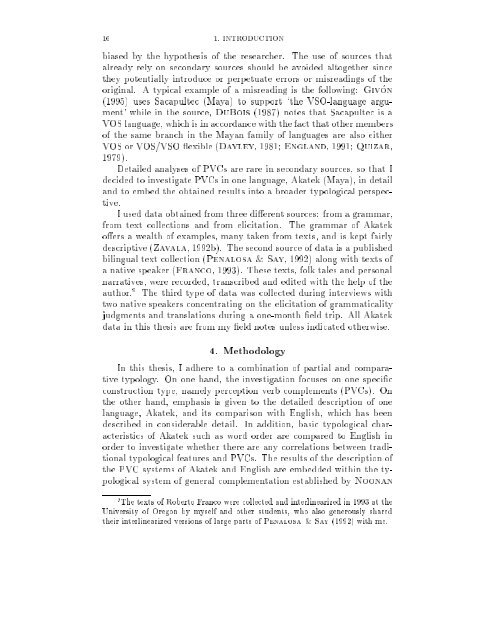Perception verb complements in Akatek, a Mayan language
Perception verb complements in Akatek, a Mayan language
Perception verb complements in Akatek, a Mayan language
You also want an ePaper? Increase the reach of your titles
YUMPU automatically turns print PDFs into web optimized ePapers that Google loves.
16 1. INTRODUCTION<br />
biased by the hypothesis of the researcher. The use of sources that<br />
already rely on secondary sources should be avoided altogether s<strong>in</strong>ce<br />
they potentially <strong>in</strong>troduce or perpetuate errors or misread<strong>in</strong>gs of the<br />
orig<strong>in</strong>al. A typical example of a misread<strong>in</strong>g is the follow<strong>in</strong>g: Givon<br />
(1995) uses Sacapultec (Maya) to support `the VSO-<strong>language</strong> argument'<br />
while <strong>in</strong> the source, DuBois (1987) notes that Sacapultec is a<br />
VOS <strong>language</strong>, which is <strong>in</strong> accordance with the fact that other members<br />
of the same branch <strong>in</strong> the <strong>Mayan</strong> family of <strong>language</strong>s are also either<br />
VOS or VOS/VSO exible (Dayley, 1981; England, 1991; Quizar,<br />
1979).<br />
Detailed analyses of PVCs are rare <strong>in</strong> secondary sources, so that I<br />
decided to <strong>in</strong>vestigate PVCs <strong>in</strong> one <strong>language</strong>, <strong>Akatek</strong> (Maya), <strong>in</strong> detail<br />
and to embed the obta<strong>in</strong>ed results <strong>in</strong>to a broader typological perspective.<br />
I used data obta<strong>in</strong>ed from three di erent sources: from a grammar,<br />
from text collections and from elicitation. The grammar of <strong>Akatek</strong><br />
o ers a wealth of examples, many taken from texts, and is kept fairly<br />
descriptive(Zavala, 1992b). The second source of data is a published<br />
bil<strong>in</strong>gual text collection (Penalosa & Say, 1992) along with texts of<br />
a native speaker (Franco, 1993). These texts, folk tales and personal<br />
narratives, were recorded, transcribed and edited with the help of the<br />
author. 9 The third type of data was collected dur<strong>in</strong>g <strong>in</strong>terviews with<br />
two native speakers concentrat<strong>in</strong>g on the elicitation of grammaticality<br />
judgments and translations dur<strong>in</strong>g a one-month eld trip. All <strong>Akatek</strong><br />
data <strong>in</strong> this thesis are from my eld notes unless <strong>in</strong>dicated otherwise.<br />
4. Methodology<br />
In this thesis, I adhere to a comb<strong>in</strong>ation of partial and comparative<br />
typology. On one hand, the <strong>in</strong>vestigation focuses on one speci c<br />
construction type, namely perception <strong>verb</strong> <strong>complements</strong> (PVCs). On<br />
the other hand, emphasis is given to the detailed description of one<br />
<strong>language</strong>, <strong>Akatek</strong>, and its comparison with English, which has been<br />
described <strong>in</strong> considerable detail. In addition, basic typological characteristics<br />
of <strong>Akatek</strong> such asword order are compared to English <strong>in</strong><br />
order to <strong>in</strong>vestigate whether there are any correlations between traditional<br />
typological features and PVCs. The results of the description of<br />
the PVC systems of <strong>Akatek</strong> and English are embedded with<strong>in</strong> the typological<br />
system of general complementation established by Noonan<br />
9 The texts of Roberto Franco were collected and <strong>in</strong>terl<strong>in</strong>earized <strong>in</strong> 1993 at the<br />
University of Oregon by myself and other students, who also generously shared<br />
their <strong>in</strong>terl<strong>in</strong>earized versions of large parts of Penalosa & Say (1992) with me.

















